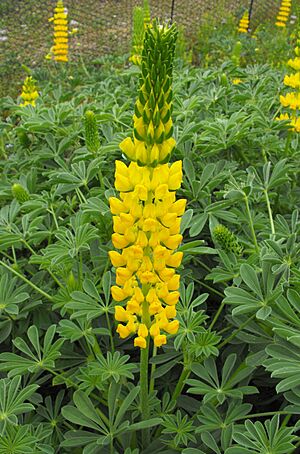Wide-bannered lupine facts for kids
Quick facts for kids Wide-bannered lupine |
|
|---|---|
 |
|
| Lupinus microcarpus var. microcarpus | |
| Scientific classification | |
| Genus: |
Lupinus
|
| Species: |
microcarpus
|
The Lupinus microcarpus, also known as the wide-bannered lupine or chick lupine, is a type of lupine plant. It grows naturally in western North America, from southwestern British Columbia down through Oregon and California. You can even find it in the Mojave Desert and into Baja California.
Interestingly, there's also a group of these plants far away in South America. They grow in central Chile and western Argentina.
Meet the Wide-Bannered Lupine
The Lupinus microcarpus is an annual plant. This means it completes its whole life cycle, from seed to flower to seed, in just one year. It can grow up to about 80 centimeters (31 inches) tall.
Its leaves are special because they are "palmately compound." This means they look a bit like the palm of your hand with fingers spreading out. Each leaf has 5 to 11 smaller leaflets. These leaflets are usually 1 to 5 centimeters (0.4 to 2 inches) long and up to 1 centimeter (0.4 inches) wide.
The flowers of this lupine are often pink or purple. But sometimes, you might see them in shades of white or yellow! They grow in open groups on a tall, straight stem.
You can find Lupinus microcarpus growing in many different places. In the northern parts of its home, it grows near the sea. But in Southern California, it can grow high up in the mountains, reaching elevations of about 1,600 meters (5,200 feet).
Different Kinds of Wide-Bannered Lupine
Scientists have found three main types, or "varieties," of Lupinus microcarpus:
- Lupinus microcarpus var. densiflorus: This type is called the whitewhorl lupine or dense-flowered lupine. It only grows in western California.
- Lupinus microcarpus var. horizontalis: This variety is special because it only grows in the deserts of southeastern California.
- Lupinus microcarpus var. microcarpus: This is the most common type. You can find it in many places, from British Columbia all the way down to Chile.
How Plants Can Help Clean Up Soil
Scientists in Chile, from the Universidad de Santiago de Chile, have been studying how plants can help clean up waste. In the city of Antofagasta, they found that some plants, like lupines, can actually take in harmful substances like arsenic from the soil. This process is called "phytoremediation," which means using plants to clean up the environment. It's a cool way plants can help keep our planet healthy!


